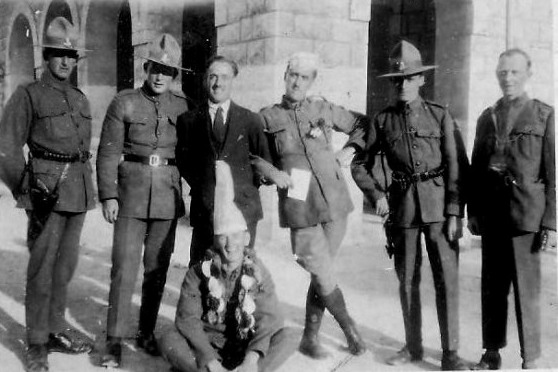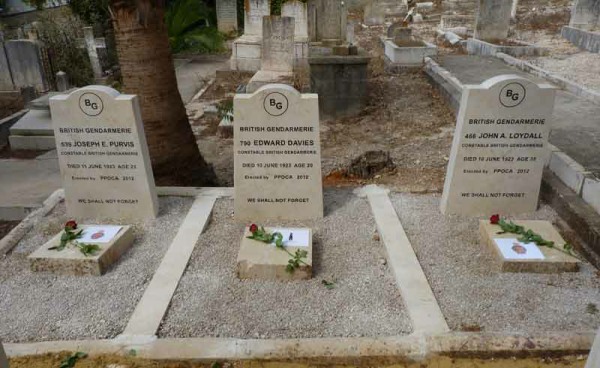Pages in Section 1

The Creation of the British Gendarmerie
i. Formation of the Palestine Police
ii. The Peoples of Palestine in 1920
iii. Early Port Police
iv. Early Clashes
v. Brief Existence of the PDF
vi. Formation of the Palestinian Gendarmerie
vii. Captain James Wesley Mackenzie
viii. 1922 Formation of the British Gendarmerie

The photo shows a group of British Gendarmerie presumably after a Christmas party. Michael Higgins, the father of Martin Higgins, a founding member of the BPPA, is second on the left.
Until April 1922, the only British members of the Palestine Police were gazetted officers. It was Winston Churchill's idea to create a British Gendarmerie to control riots in Mandatory Palestine. He envisaged it as an elite paramilitary mounted police force similar to the Royal Canadian Mounted Police or South African Constabulary, hence the headgear shown in the photo.
Despite the rates of pay being only 50% of that of the RIC before the partition of Ireland, many of the British Palestine Gendarmerie's 43 officers and 700 other ranks were recruited from the former RIC and an RIC Auxiliary Division (ADRIC)made up from military officers who had served in WW 1. Some of the more reputable members of the Black and Tans also managed to join the other ranks of the Gendarmerie although not officially recruited.
At the end of April 1922, 650 British gendarmes, men-at-arms, clambered out of flat barges on to Haifa's jetty.
Althogh intendeded to operate as a mounted force, lack of funds meant there were not enough horses, so many served on foot. The Gendarmerie was structured into 6 companies and a Headquarters unit.
A year after their arrival 60% of the new recruits resigned due to poor pay and unsatisfactory living conditions
The first British Gendarmes to die in action were Joseph Purvis, Edward Davies and John Loydall, killed by Bedouin bandits in 1923. The graves were lost for many years but were recently rediscovered by Israeli citizen, Michael Gottschalk who has spent his retirement researching lost British graves and chasing funding to refurbish them. The upkeep of graves of British Gendarmerie and Police buried in Palestine is a stated purposes of the BPPA.

About this photo -
I have several photos of these refurbished graves,but this one that I found it on the web uploaded by a gentleman named Michael Robson, seems best for this page. I don't know how to get in touch with him for permission to use it. If Mr Robson comes across this page, and objects to my using the photo would he please get in touch with me and I will substitute it with another photo.